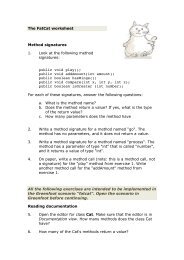SCIENCE TEST
SCIENCE TEST
SCIENCE TEST
Create successful ePaper yourself
Turn your PDF publications into a flip-book with our unique Google optimized e-Paper software.
4<br />
Experiment 2<br />
The students added 1 L of the flat-tasting beverage to<br />
sted their hypothesis that the pres- an empty can. They sealed the can, shook it, and set it<br />
s of various liquids would affect the<br />
Experiment 2 aside. Fifteen minutes later they found the roll time of the<br />
ook a can to roll, without slipping,<br />
The students added 1 L can of the before flat-tasting and immediately beverage to an after empty shaking can. They it sealed (Trial the 4).<br />
en 2 fixed points; see Figure 1).<br />
can, shook it, and set it<br />
aside. Fifteen minutes later<br />
Again<br />
they<br />
they<br />
found<br />
set<br />
the<br />
the<br />
roll<br />
can<br />
time<br />
aside.<br />
of the<br />
Two<br />
can<br />
hours<br />
before<br />
later<br />
and immediately<br />
they found<br />
after shaking it<br />
the roll time of the can before and immediately after shak-<br />
(Trial 4). Again they set ing the it can (Trial aside. 5). Two The results hours later are they shown found in Table the roll 2. time of the can before and<br />
immediately after shaking it (Trial 5). The results are shown in Table 2.<br />
fixed points incline<br />
gle of<br />
clination<br />
Figure 1<br />
can<br />
Experiment 3<br />
The students added 1 L of the flat-tasting beverage to an empty 2 L clear plastic bottle and sealed the bottle.<br />
um cans were used<br />
When<br />
in the<br />
they<br />
first<br />
rolled<br />
two<br />
the bottle Experiment down the 3 incline, no bubbles formed. They shook the bottle, causing bubbles to<br />
le of inclination of the incline was<br />
ments.<br />
form, and set the bottle aside. The Fifteen students minutes added later, 1 L some of the bubbles flat-tasting were still beverage visible, to but after 2 hours, no<br />
bubbles could be seen. an empty 2 L clear plastic bottle and sealed the bottle.<br />
When they rolled the bottle down the incline, no bubbles<br />
Adapted from David Kagan, formed. “The Shaken-Soda They shook Syndrome.” the bottle, ©2001 causing by The American bubbles Association to form, of Physics Teachers.<br />
and set the bottle aside. Fifteen minutes later, some bubbles<br />
were still visible, but after 2 hours, no bubbles could<br />
11. In Experiment 3, what be seen. is the most likely reason the students used the plastic bottle rather than an<br />
aluminum can? Compared to an aluminum can, the plastic bottle:<br />
A. rolled more rapidly down the incline.<br />
B. made bubbles Adapted in the liquid from David easier Kagan, to see. “The Shaken-Soda Syndrome.” ©2001<br />
by The American Association of Physics Teachers.<br />
C. contained a greater quantity of liquid.<br />
D. had thicker walls and was less likely to break.<br />
Answer: B.<br />
d 1 L of a liquid—tap water containempty<br />
can, sealed the can, and found<br />
ey added 1 L of the tap water to a<br />
aled it, shook it, and immediately<br />
ey repeated these procedures using<br />
g many bubbles, and a carbonated<br />
ed no bubbles and that tasted flat,<br />
carbonation. The results are shown<br />
12. Based on the results 11. of Experiments In Experiment 1 and 3, what 2, in is which the most of the likely following reason trials, the before stu- shaking, were the<br />
average speeds of the cans the dents same? used the plastic bottle rather than an aluminum<br />
F. Trials 1 and 2 can? Compared to an aluminum can, the plastic bottle:<br />
G. Trials 2 and 3 A. rolled more rapidly down the incline.<br />
Table 1<br />
H. Trials 2 and 4 B. made bubbles in the liquid easier to see.<br />
J. Trials 3 and 5 C. contained a greater quantity of liquid.<br />
Roll time<br />
D. had thicker walls and was less likely to break.<br />
We are told that the plastic bottle is clear. We are also told that in Experiment 3, bubbles<br />
are visible after 15 minutes, but not after 2 hours. There is no mention of seeing any<br />
bubbles in the other experiments.<br />
Answer: J.<br />
Table 2<br />
Roll time<br />
before shaking after shaking<br />
Trial (sec) (sec)<br />
4 1.86 1.96<br />
5 1.75 1.93<br />
before shaking after shaking 12. Based on the results of Experiments 1 and 2, in which<br />
(sec) (sec)<br />
of the following trials, before shaking, were the aver-<br />
1.75<br />
1.97<br />
1.75<br />
age speeds of the cans the same?<br />
Trials 1.75 3 and 5 both have speeds of 1.75 seconds before shaking.<br />
2.15<br />
F. Trials 1 and 2<br />
13. In 1.96<br />
G. Trials 2 and 3<br />
Experiment 2, a result H. of Trials shaking 2 and the can 4 of flat-tasting beverage was that the:<br />
A. number of bubbles J. in the Trials beverage 3 and immediately 5 decreased.<br />
B. mass of the can of beverage increased.<br />
C. roll time of the can of beverage decreased.<br />
D. roll time of the can of beverage increased. GO ON TO THE NEXT PAGE.<br />
46



